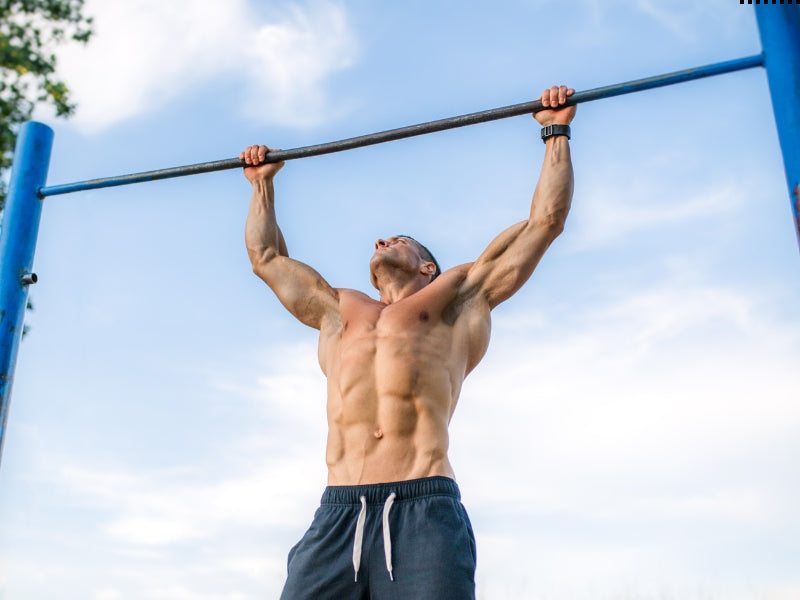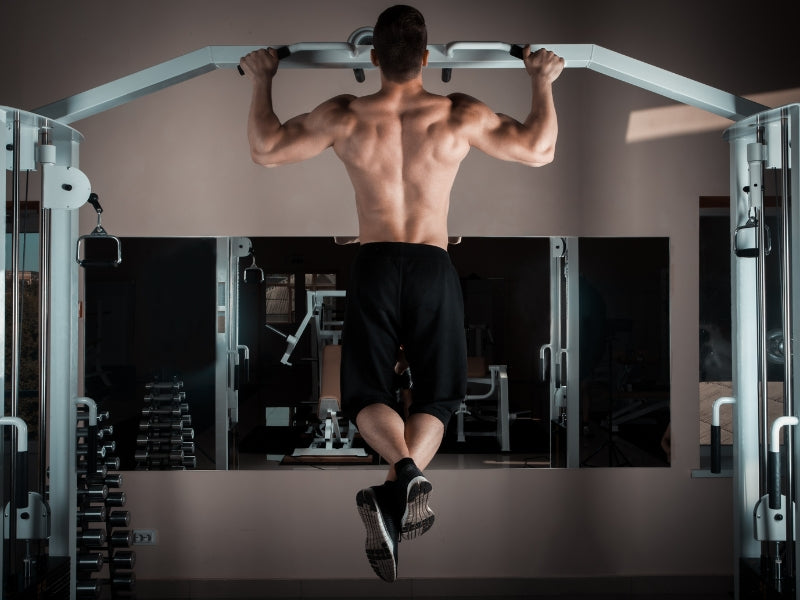Perhaps one of the most difficult exercises to perform at the gym is the pull-up. If you want to build a whole lot of muscle and strength in your upper body, particularly in your arms, shoulders, and upper back, then the pull-up is one of the best exercises you could do.
There are a wide range of pull-up variations, all of which we will take a look at today, and they all work slightly different muscles.
But we want to figure out which muscles pull-ups work, and what the difference is between the pull-up variations in terms of the muscles worked. This way you can incorporate the pull-ups into your workout to help you reach your training goals.
What is a Pull-Up?

For those of you who don't know what a pull-up is, this is generally done on something like a pull-up bar, which may be attached to a wall, or door frame, or be its own freestanding structure.
Doing a pull-up involves holding the handles at roughly elbow width apart, with your feet hanging down.
The goal is to pull yourself upwards until your chin reaches the bar. A defining characteristic of the pull-up is that your arms or palms face away from your body.
This is where the different variations come into play, because whereas a pull-up has you holding the bar with your palms facing away from you, a chin-up has you holding the bar with your palms facing towards you, resulting in slightly different muscles being worked.
Another variation is a pull-up using a neutral grip, which is characterized by your palms facing inward.
As you might be able to tell, this combines both the chin-up and the pull-up and offers a balanced mix of both. Let's move on and take a closer look.
Muscles Worked by Pull-Ups

There are six major muscles or muscle groups worked by the pull-up exercise, so let's take a quick look at what each of them are.
Latissimus Dorsi

The lats, officially known as the latissimus dorsi, is the muscle located on your back, the flat muscle or muscles located under and to the rear of your armpits.
If we were to assign a shape to them, they would look like a triangle, and part of them is covered by the trapezius muscle in the middle of your back.
The lats are very important for helping you to move your upper arms in towards your body when you're doing pull-ups. In fact, most of the power you need to do a pull-up comes from the latissimus dorsi muscle.
Technically speaking, the latissimus dorsi pulls on your upper arms, which causes them to move closer to the body, with the result being that your body rises up into the air and towards the pull-up bar.
Trapezius

The next muscle that gets worked out when doing a pull-up is the trap or trapezius muscle.
The trapezius muscle is located in the middle of the back and extends from the top of the neck out to the beginning of the shoulder, and down to roughly the center of your lower back on either side of the spine.
This muscle is crucial for any sort of pulling movement, and yes, it's required to lift yourself up into the air.
Any pulling motion that lifts you up into the air stimulates the trapezius muscle, and along with your lats, it takes the brunt of the force when doing a pull-up.
It's both your lats and your traps that work the hardest when doing this exercise.
Biceps
The next muscle that gets worked out when you do a pull-up is your bicep. Although many people might think that doing bicep curls is the only way to train your biceps, this isn't true.
Any type of pulling motion, such as a pull-down, a pull-up, or rowing, utilizes your upper arms, engaging your biceps.
You need your biceps to bend your elbows and pull your arms towards your body. Your lats, traps, and biceps all work together to pull yourself up to the bar, and then to lower yourself back down.
With that being said, biceps curls are better than pull-ups for exercising your biceps, but that is not to say that pull-ups don't work these muscles at all.
It's certainly better than nothing, and it makes for a good complement to your regular bicep workouts.
Pecs
Your pecs or pectoralis major, simply known as your chest muscle, is yet another muscle that the pull-up works.
Just like with your biceps, many people might not be aware that doing a pull-up works out your chest, but this is true.
Although your chest is mainly used for pushing motions, when you use your lats to pull your arms towards your body, it requires the pectoralis major muscle as support.
Without your pecs, pulling your arms closer towards your body would be nearly impossible.
Of course, the pull-up is not the number one pec or chest exercise out there, as something like a chest fly or bench press is much better. But your chest is engaged during a pull-up and gets worked.
The Deltoids

Another muscle group worked by performing pull-ups are the deltoids and in this case quite specifically the rear deltoid.
The rear deltoid is a pretty important muscle as far as pulling motions are concerned.
It's also one of the muscles that you would use when doing any kind of rowing motion that has you pulling a weight upwards from the ground.
Just like with your biceps and pecs, the pull-up is not the number one exercise for the deltoids, but it still works them out to a certain degree.
There are also ways to stimulate your deltoid muscles more when doing a pull up, such as by using a wider grip.
The wider your grip, the more you activate your deltoid muscles. The neutral grip also puts quite a lot of strain on the deltoids.
The Teres Major, Infraspinatus & Teres Minor
We then have three other muscles which pull-up works, most of which the majority of people probably have never heard of.
First, we have the teres major muscle, which is found above the lats, and attaches to the humerus and the scapula.
Second, we have the infraspinatus, which spans across the whole back from shoulder blade to shoulder blade, and finally, we have the teres minor, which is located directly on top of the teres major.
These are three muscles that help your lats pull your arms towards your body, which is important for doing pull-ups, as we have established.
Pull-Up Variations
Now that we know all of the major muscles worked out by the pull-up exercise, let's take a quick look at pull-up variations and how exactly they work your muscles.
The Chin-Up

First, we have the chin -up, which as we mentioned above, has your palms facing towards you instead of away from you.
You're still pulling yourself upwards, but you're just reversing the position of your hands.
When you do chin-ups, it activates your biceps muscles much more than when doing pull-ups.
Yes, all of the other muscles are worked just the same, but here you're putting more of an emphasis on your biceps.
Neutral or Hammer Grip Pull-Up

We then have the hammer grip or neutral grip pull-up, which sees your palms facing inwards. Neutral grip pull-ups are great if you are looking to achieve a balance between all of your muscles.
You could almost look at it as the middle ground between a chin-up and a pull-up, as it works your biceps a little bit more than a pull-up, but a little bit less than a chin-up.
Furthermore, when you do a neutral grip pull-up, it also stimulates your forearm muscles as well as your brachialis, both of which don't really get targeted all that much with regular pull-ups.
Wide Grip Pull Ups

Last but not least we have the wide grip pull-ups which many consider to be the hardest pull-up of all.
The wide grip emphasises the resistance onto your lats and trap muscle while also requiring your biceps to work hard for each rep.
To perform a wide grip pull-up your hands should be slightly wider than your shoulders so that when your chin reaches the bar your arms are bent at 90 degrees.
Many people just getting started on their fitness journey likely can't complete a rep of this variation but with enough consistent training it is possible.
Rounding Up
What it really comes down to is that pull-ups are some of the best body weight exercises out there.
All you need is a pull-up bar and your arms, and you can work out virtually every major muscle in your upper body.





